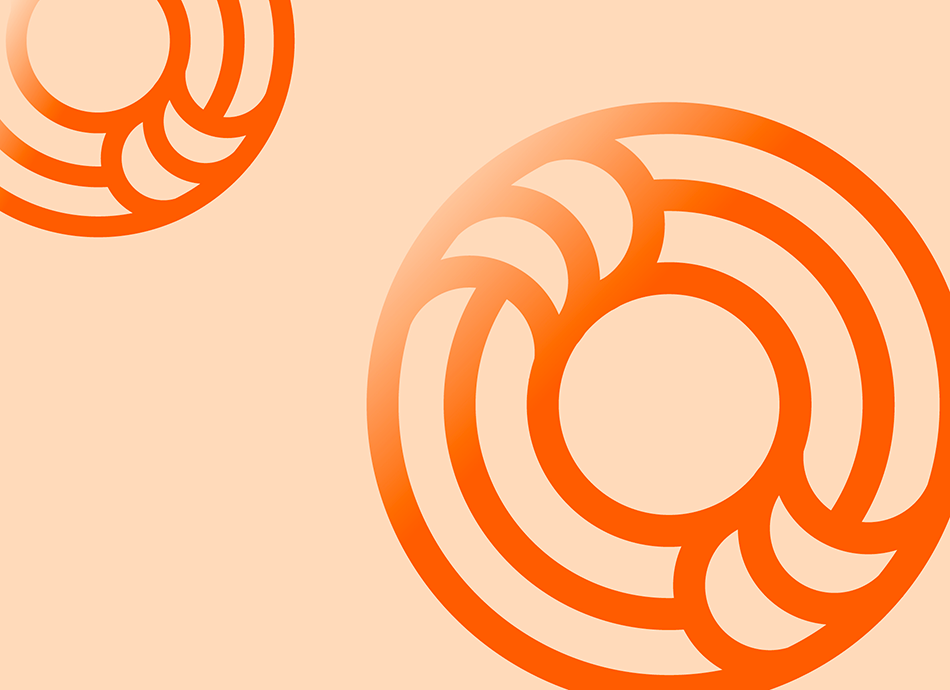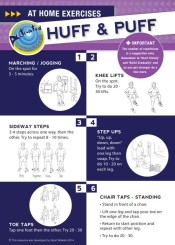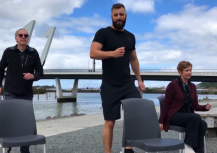Wishing everyone happy holidays and a joyful New Year from the Healthify team. Don't forget to Slip, Slop, Slap and Wrap!
Physical activity for healthcare providers
Key points about physical activity
- This page contains information about physical activity for healthcare providers.
- Find information on guidelines and exercises you can recommend to patients.

The Ministry of Health's Eating and activity guidelines for New Zealand adults(external link) has the following 5 key recommendations on activity:
- Sit less, move more! Break up long periods of sitting.
- Do at least 2.5 hours of moderate or 1.25 hours of vigorous physical activity spread throughout the week.
- For extra health benefits, aim for 5 hours of moderate or 2.5 hours of vigorous physical activity spread throughout the week.
- Do muscle strengthening activities on at least 2 days each week.
- Doing some physical activity is better than doing none.
There's no shortage of evidence that regular physical activity is good for healthy adults. Read more about the general benefits of being active.
Evidence suggests that physical activity is important in preventing or delaying long-term conditions,4 especially:
- cardiovascular diseases such as hypertension, coronary heart disease, heart failure, intermittent claudication and strokes
- pulmonary diseases such as COPD, asthma, cystic fibrosis
- some cancers
- musculoskeletal disorders such as osteoarthritis, osteoporosis, back pain and rheumatoid arthritis
- falls in older people
- metabolic diseases such as obesity, hyperlipidaemia, type 2 and type 1 diabetes
- mental health conditions such as depression, anxiety, stress and schizophrenia
- polycystic ovarian syndrome
- neurological disorders such as dementia, Parkinson's disease and multiple sclerosis.5
Physical activity and exercise help medical management of the condition, provide social benefits and increase quality of life for people with long-term conditions.
Treatment of long-term conditions is better managed when physical activity and exercise are part of the medical management plan.
There is also evidence10,11 that supports self-management approaches to exercise. Programmes prescribed for long-term conditions are more effective when they include strategies such as self-monitoring and action planning.
Home- and clinic-based programmes have been found equally effective in improving health-related quality of life in patients with long-term conditions.
Chronic pain
There is also no shortage of evidence on the effectiveness of physical activity and exercise on chronic pain.
Chronic pain is any pain that lasts longer than 12 weeks.7 About 1 in 6 New Zealanders live with chronic pain, and no two people are affected in the same way. Chronic pain can further contribute to disability, anxiety, depression, sleep disturbances, poor quality of life and healthcare costs.
- Physical activity and exercise programmes are increasingly being promoted as an effective treatment for chronic pain.7
- Any form of exercise has the same effect on pain reduction.6
- Physical activity and exercise is an intervention with few adverse events and may improve pain severity and physical function and consequently improve quality of life.7
- Physical activity, such as individualised physical exercise, yoga and pilates, tai chi and qigong, has been demonstrated to lead to significant improvements in neck pain intensity and disability.8
- Exercise is effective in the primary and secondary prevention of low back pain.
- When used for curative treatment, exercise reduces disability and pain severity while also improving fitness and occupational status in people who have subacute, recurrent or chronic low back pain.9
More studies are needed to assess the effectiveness of different types of exercise on chronic pain and which patient subsets respond to specific characteristics of exercise programmes.
Simple exercises to get started – Exercises from Sport Auckland
Video: Abdominal and Lower back exercises
The following videos for simple exercises are good for people not living with pain or a condition that makes them anxious about trying things and if not done properly could cause pain or loss in confidence.
(Sport Auckland, NZ, 2015)
Video: Building the Core!
(Sport Auckland, NZ, 2015)
For more videos of the same series, visit Simple exercises(external link).
These activity guides and activity plans come from different sports organisations around New Zealand. Patients and clients can ask their healthcare providers about suitable exercises for them.
Green Prescription and intensity
A Green Prescription is a written advice to clients to encourage them to become more physically active as part of their health management. Green Prescriptions are for anyone who needs to be more active. There are 2 programmes:
Green Prescription for adults
This is for adults who need help to get more active again. Read more about Green Prescriptions.
Green Prescription Active Families Programme
This Health New Zealand | Te Whatu Ora programme for school-aged children tries to establish good habits and prevent overweight children becoming unhealthy adults. Activity and nutritional advice is provided to families through weekly group sessions or home visits. Read more about the Active Families Programme.
Find a Green Prescription contact(external link) and an Active Families contact(external link) in your area.
Physical activity, sedentary behaviour and heart health(external link) Heart Foundation, NZ, 2021
Physical activity in the treatment of long term conditions course(external link) BMJ Learning, UK
Consultation guides(external link) Moving Medicine, UK
- Ministry of Health. Eating and activity guidelines for New Zealand adults(external link) Ministry of Health, NZ, 2020
- Reiner M, Niermann C, Jekauc D, et al. Long-term health benefits of physical activity – a systematic review of longitudinal studies(external link). BMC Public Health. 2013;13, 813. doi:10.1186/1471-2458-13-813
- Anderson E, Durstine JL, et al. Physical activity, exercise, and chronic diseases: A brief review(external link) Sports Medicine and Health Science. 2019;1(1): 3-10.
- Booth FW, Roberts CK, Laye MJ. Lack of exercise is a major cause of chronic diseases(external link) In Comprehensive Physiology, R. Terjung (Ed.). 2012. doi:10.1002/cphy.c110025
- Pedersen BK, Saltin B. Exercise as medicine – evidence for prescribing exercise as therapy in 26 different chronic diseases(external link) Scand J Med Sci Sports, 2015; 25: 1-72. doi:10.1111/sms.12581
- Lim EC, Poh RL, Low AY, Wong WP. Effects of Pilates-based exercises on pain and disability in individuals with persistent nonspecific low back pain: a systematic review with meta-analysis(external link) J Orthop Sports Phys Ther. 2011;41(2):70-80. doi:10.2519/jospt.2011.3393
- Geneen LJ, Moore RA, Clarke C, Martin D, Colvin LA, Smith BH. Physical activity and exercise for chronic pain in adults: an overview of Cochrane Reviews(external link) Cochrane Database of Systematic Reviews 2017, Issue 4. Art. No.: CD011279. doi:10.1002/14651858.CD011279.pub3.
- The effectiveness of general physical exercise for individuals with chronic neck pain: a systematic review of randomised controlled trials(external link) European Journal of Physiotherapy. 2020;22:3, 141-147, doi:10.1080/21679169.2018.1561942
- Henchoz Y, Kai-Lik So A. Exercise and nonspecific low back pain: a literature review(external link) Joint Bone Spine. 2008;75(5):533-539. doi:10.1016/j.jbspin.2008.03.003
- Anderson L, Taylor RS. Cardiac rehabilitation for people with heart disease: an overview of Cochrane systematic reviews(external link) Int J Cardiol. 2014;177(2):348–61.
- Dalal HM, Zawada A, Jolly K, Moxham T, Taylor RS. Home based versus Centre based cardiac rehabilitation: Cochrane systematic review and meta-analysis(external link). Br Med J. 2010;340:b5631.
- Green Prescriptions(external link) Health New Zealand | Te Whatu Ora
- Physical activity(external link) Health New Zealand | Te Whatu Ora
Credits: Healthify editorial team. Healthify is brought to you by Health Navigator Charitable Trust.
Page last updated:




